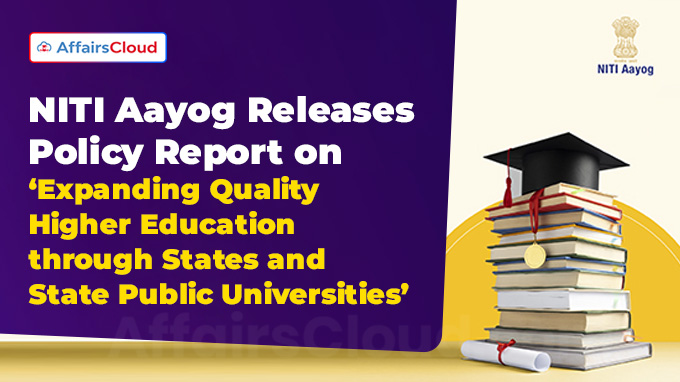 In February 2025, National Institution for Transforming India (NITI Aayog) released a policy report titled ‘Expanding Quality Higher Education through States and State Public Universities’, a first-of-its kind policy document in the higher education sector focused specifically on states and State Public Universities (SPUs).
In February 2025, National Institution for Transforming India (NITI Aayog) released a policy report titled ‘Expanding Quality Higher Education through States and State Public Universities’, a first-of-its kind policy document in the higher education sector focused specifically on states and State Public Universities (SPUs).
- The report provides detailed quantitative examination on important indicators of Quality, Funding & Financing, Governance and Employability over the last 10 years across the themes.
- The report is in alignment with targets of the National Education Policy (NEP) 2020 and part of Government of India (GoI)’s ‘Viksit Bharat 2047’.
Key People: The report was formally launched by Suman Bery, Vice Chairman, NITI Aayog; Dr. Vinod Kumar Paul, Member (Education); NITI Aayog; BVR Subramanyam, Chief Executive Officer (CEO), NITI Aayog; Vineet Joshi, Secretary, Department of Higher Education (DoHE), Ministry of Education (MoE) and Dr. Pankaj Mittal, Secretary General, Association of Indian Universities (AIU) in New Delhi, Delhi.
About the Report:
i.The report is prepared in consultations with state government officers of Higher and Technical Education departments from more than 20 states and Union Territories (UTs), Vice Chancellors (VCs), and senior academicians of 50 SPUs, and heads of State Higher Education Councils (SHECs).
ii.The report provides nearly 80 policy recommendations across 4 main indicators, along with a detailed implementation roadmap that covers short-term, medium-term, and long-term strategies.
- It also features more than 125 performance success indicators used to measure the progress of the recommendations. It will help in monitoring the success of initiatives across 4 main indicators.
iii.These policy recommendations aimed to improve the quality of research, pedagogy, and curriculum, increasing institutional and systemic funding and financing capacity, enhancing and empowering institutional governance structures, and strengthening industry-academia interface to boost student employability.
iv.All the key findings of the reports are sourced from the All India Survey on Higher Education (AISHE) report 2021-22, prepared by the MoE.
Key Findings:
i.Top Performing States in Gross Enrolment (GER) in Higher Education Institutions (HEIs) in 2021-22: Tamil Nadu (TN), Himachal Pradesh (HP), Uttarakhand, and Kerala. These states are grouped under the “achievers” category.
- Kerala, Chhattisgarh and HP have higher female enrolment rates than males, serving as models of success for greater access to higher education for women.
ii.Worst Performing States in GER in HEIs in 2021-22: Sikkim, Andhra Pradesh (AP), and Karnataka. These states are grouped under the ‘front-runners’ category.
iii.Pupil-Teacher Ratio(PTR): The report revealed that PTR was lowest in universities of states like: TN, Goa, and Karnataka.
- While, PTR was highest in universities of states: Jharkhand and Bihar.
- Top 3 Performing States in terms of decadal improvement in PTR (2011-12 compared to 2021-22): Arunachal Pradesh (AR), Uttarakhand, and West Bengal (WB).
iv.Higher Education budgets of States: Considering higher education expenditure as a percentage of Gross State Domestic Product (GSDP), Bihar ranks highest at 1.56%, followed by Jammu and Kashmir(J&K) at 1.53% and Manipur at 1.45%. Telangana has the lowest percentage at 0.18%, while Gujarat and Rajasthan allocate 0.23% each.
- Among all states and UTs, J&K spends the most for education as a percentage of GDP at 8.11%, followed by Manipur (7.25%), Meghalaya (6.64%), and Tripura (6.19%). While Delhi (1.67%), Telangana (2%), and Karnataka (2.01%) allocate significantly less towards higher education.
- Maharashtra leads in higher education funding with a budget of Rs.11,421 crore, followed by Bihar (Rs.9,666 crore) and TN (Rs.7,237 crore).
- States like Sikkim (Rs. 142 crore), Arunachal Pradesh.AR (Rs.155 crore), and Nagaland (Rs.167 crore) have the lowest higher education budgets.
- The mean per youth expenditure on HE rose from Rs.2,174 to Rs.4,921 between 2005-06 and 2019-20.
v.College Density: It is defined as the total number of colleges per 1 lakh eligible population aged from 18 to 23 years, in a state.
- States with highest college densities: Karnataka with a college density of 66, which is more than double of the national average (30 in 2022), has the highest college density among all states, followed by Telangana (52), AP (49), HP (47), and Kerala (46).
- UT Puducherry has the highest college density of 53 among all UTs in the country.
- States with least college densities: Manipur (3), Bihar (7) and Jharkhand (8).
vi.University Density: It is defined as the total number of universities per 1 lakh eligible population aged from 18 to 23 years, in a state. As per the report, the national average university density is 0.8.
- States with highest average university density: Sikkim (10.3), followed by AR (5.6), UT Ladakh (5.2), HP (4), Meghalaya (2.9), and Uttarakhand (2.8). All these states are sparsely populated.
- States with least average university density: Bihar (0.2), UP (0.3), WB (0.6) and Maharashtra (0.6). All these states are densely populated.
vii.SPUs: As per the report, India has 495 SPUs, accounting 81% of the total student enrolment among Indian HEIs.
- States with highest number of SPUs are: Karnataka (43), followed by WB and UP with 38 each.
Points to Note:
- As per the AISHE report 2021-22, there were 1,168 universities; 45,473 colleges and 12,002 standalone institutions in India.
- The literacy rate was alarmingly low at 14%, and expenditure on education constituted less than 0.5% of the national income.
Key Policy Recommendations:
i.Quality:
- To frame National Research Policy (NRP) in alignment with the Anusadhan National Research Foundation (ANRF);
- Setting-up of research hubs within groups of SPUs to foster collaboration;
- Improve funding for post-doctoral fellowships: especially for women in SPUs; to create Centres of Excellence(CoE) in cluster of SPUs to address local challenges
- Formation of Multidisciplinary Education and Research Universities (MERUs) to fix gaps in Research and Development (R&D), among others.
ii.Funding and Financing:
- To increase the contribution central government as well as state governments towards higher education, aiming to achieve 6% of Gross Domestic Product (GDP) as recommended by the NEP 2020;
- To setup a dedicated infrastructure finance agency specifically for SPUs;
- To foster collaborations with industry bodies and promote mobilization of Corporate Social Responsibility (CSR) funds towards R&D infrastructure in SPUs; among others.
iii.Governance:
- To implement policy changes at the State and Central government levels to grant tax exemptions on revenue from CSR grants and educational and research activities.
- Bolstering the role of State Councils for Higher Education (SCHEs) in fund distribution and policy execution;
- To frame State-level Higher Education Vision for 2047;
- Improving the autonomy of SPUs in administrative matters and introducing reforms in the faculty recruitment process, among others.
iv.Employability:
- Establishing Industry Relations Cell (IRC) in universities to foster collaborations;
- Launching of skill certification programs in collaboration with industry organisations like: Confederation of Indian Industry (CII), Federation of Indian Chambers of Commerce & Industry (FICCI), and National Association of Software and Services Companies (NASSCOM);
- Setting-up of incubation centres or co-working spaces to support student-led startups; among others.
About National Institution for Transforming India (NITI) Aayog:
Chief Executive Officer (CEO) – B.V.R. Subrahmanyam
Headquarters- New Delhi, Delhi
Established – 2015




